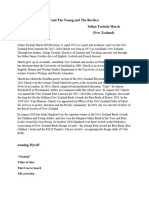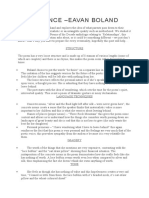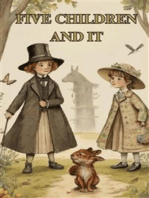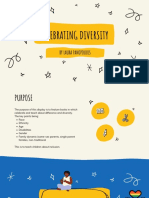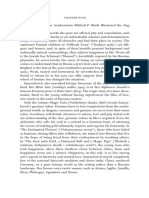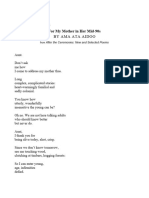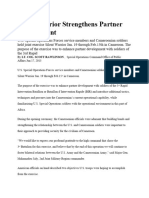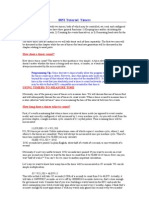0 ratings0% found this document useful (0 votes)
317 viewsProse May 2005 Paper 1
Prose May 2005 Paper 1
Uploaded by
GabbyRainaThis passage depicts an aging mother whose depression is alleviated when her middle daughter gives her a loom. Through weaving, the mother is able to reconnect with her role as a mother and find community. The author uses minimal dialogue, characterization, and symbolic imagery of weaving and nature to represent the complex bonds of family life.
Copyright:
© All Rights Reserved
Available Formats
Download as DOCX, PDF, TXT or read online from Scribd
Prose May 2005 Paper 1
Prose May 2005 Paper 1
Uploaded by
GabbyRaina0 ratings0% found this document useful (0 votes)
317 views1 pageThis passage depicts an aging mother whose depression is alleviated when her middle daughter gives her a loom. Through weaving, the mother is able to reconnect with her role as a mother and find community. The author uses minimal dialogue, characterization, and symbolic imagery of weaving and nature to represent the complex bonds of family life.
Original Description:
Ib English
Copyright
© © All Rights Reserved
Available Formats
DOCX, PDF, TXT or read online from Scribd
Share this document
Did you find this document useful?
Is this content inappropriate?
This passage depicts an aging mother whose depression is alleviated when her middle daughter gives her a loom. Through weaving, the mother is able to reconnect with her role as a mother and find community. The author uses minimal dialogue, characterization, and symbolic imagery of weaving and nature to represent the complex bonds of family life.
Copyright:
© All Rights Reserved
Available Formats
Download as DOCX, PDF, TXT or read online from Scribd
Download as docx, pdf, or txt
0 ratings0% found this document useful (0 votes)
317 views1 pageProse May 2005 Paper 1
Prose May 2005 Paper 1
Uploaded by
GabbyRainaThis passage depicts an aging mother whose depression is alleviated when her middle daughter gives her a loom. Through weaving, the mother is able to reconnect with her role as a mother and find community. The author uses minimal dialogue, characterization, and symbolic imagery of weaving and nature to represent the complex bonds of family life.
Copyright:
© All Rights Reserved
Available Formats
Download as DOCX, PDF, TXT or read online from Scribd
Download as docx, pdf, or txt
You are on page 1of 1
Jan Lowman
English A1 HL, Paper #1. (a)
Introduction to a Commentary on a Passage from R L Sasakis The Loom
This passage depicts a family, in particular an aging mother and her daughters. The mothers depression,
perhaps a result of her empty nest after a lifetime of child-rearing, is alleviated when her middle
daughter, Sharon, gives her a loom. Through her weaving, the mother revisits the days when she was
central to her daughters lives, becomes part of a community of weaving friends, and finds a subtle
means of expression of her own internal colors. Sasakis minimalistic use of dialogue and
characterization, her color and nature imagery, and the archetypal symbolism of weaving and the loom
all combine to evoke the miraculous, mystical fabric of family life.
II. Sasakis understated dialogue and characterization demonstrate the tensions and underlying love
between the characters.
A. Movement from I give up to Youd never know it unless you looked real close. Jo
1. Figurative quality to opening descriptions of the mothers state
2. Abroad, Michael, leaving. . .
B. Lindaloyal, staunch; Terrys mother at Bachans houseno dialogue?
C. Sharongave her mother a loom, helpful, teaching/gallery, Put it on
D. blue, Cathys favorite colordead? Otherwise absent?
III. Color and nature imagery evoke the nostalgic beauty of the mothers relationship to her children and
the subdued loveliness of the mother herself.
A. Allusion? bending to the loom with painstaking attention, threading the warp tirelessly,
endlessly winding, threading, tying
B. five inches of one weave, two inches of anotherprecise, exact, small
C. Colorssubdued, neutral but with flashes of color (You know, theres actually red in here. .
. and even bits of green.) The need to look closely!
D. Golden brownCentral Valley
E. Cool, emerald watersMerced River
F. Foodeggs, pickled vegetables, white rice balls
IV. Archetypal symbolism of the loom and weaving enlarge this passage into an evocation of the
timeless care of maternal affection.
A. Ll. 14-20 (hidden color, like the mothers hidden personality)
B. The muffler was warm about Jos necksymbol of maternal caring
C. Final sentencelink to universal womanhood
V. Rephrasing of Sasakis minimalistic use of dialogue and characterization, her color and nature
imagery, and the archetypal symbolism of weaving and the loom all combine to evoke the miraculous,
mystical fabric of family life. The initial impression that the mother is mentally ill, echoed subtly at the
end as she leans as an object of lighter mass naturally tends toward a more substantial one, dissipates
with because of the therapeutic weaving.
You might also like
- MoaninDocument1 pageMoaninyadda100% (3)
- TOSCANINI, by Harvey Sachs: Supplementary ChaptersDocument415 pagesTOSCANINI, by Harvey Sachs: Supplementary ChaptersLiveright Publishing100% (10)
- Lemontree HotelsDocument20 pagesLemontree HotelsUrvashi BaralNo ratings yet
- Aunt JenDocument9 pagesAunt Jencheyenne collesso75% (4)
- Teaching English in The Elementary Grades Through LiteratureDocument11 pagesTeaching English in The Elementary Grades Through LiteratureApril Jade Mendoza100% (7)
- Walk Two Moons, Themes Motifs Symbol. Study NotesDocument3 pagesWalk Two Moons, Themes Motifs Symbol. Study NoteshskyaNo ratings yet
- SummaryDocument12 pagesSummarydebajyoti chakrabortyNo ratings yet
- Analysis of "The Cruel Mother" BalladDocument7 pagesAnalysis of "The Cruel Mother" BalladDustin Doss100% (1)
- The Dolls HouseDocument4 pagesThe Dolls HouseAmelyn Albitos-Ylagan Mote100% (1)
- The Mats - Is a-WPS OfficeDocument6 pagesThe Mats - Is a-WPS OfficeCharess DelareNo ratings yet
- Patricia Polacco Power Point - Childrens LitDocument22 pagesPatricia Polacco Power Point - Childrens LitKiel O'DonnellNo ratings yet
- Purple Hibiscus and Aunt JenDocument6 pagesPurple Hibiscus and Aunt Jenlloydia67% (9)
- 2.6 New ZealandDocument8 pages2.6 New ZealandSreelakshmi SureshNo ratings yet
- The Art of Katherine MansfieldDocument18 pagesThe Art of Katherine MansfieldBellaZiaNo ratings yet
- The Reservoir NotesDocument3 pagesThe Reservoir NotesalviratripathiNo ratings yet
- GCSE English Literature Poems Cold Knap LakeDocument2 pagesGCSE English Literature Poems Cold Knap LakeSahib MatharuNo ratings yet
- Academic Journal Article Caribbean QuarterlyDocument2 pagesAcademic Journal Article Caribbean QuarterlySeondre Daye100% (1)
- Inheritance - Eavan BolandDocument5 pagesInheritance - Eavan BolandnefNo ratings yet
- Dream Children As An EssayDocument4 pagesDream Children As An EssayQuizzy Hindoli MitraNo ratings yet
- MIL ActivityDocument2 pagesMIL ActivityJego ManloloNo ratings yet
- Emily DickinsonDocument10 pagesEmily DickinsonLidia SNo ratings yet
- The Time of The PeacockDocument1 pageThe Time of The PeacockSeetha ElangoNo ratings yet
- Celebrating Diversity - LPDocument10 pagesCelebrating Diversity - LPapi-298163901No ratings yet
- Mystery To Me Event ScheduleDocument9 pagesMystery To Me Event ScheduleMichelle SkadalNo ratings yet
- The Legendary and Poetical Remains of John Roby author of 'Traditions of Lancashire', with a sketch of his literary life and characterFrom EverandThe Legendary and Poetical Remains of John Roby author of 'Traditions of Lancashire', with a sketch of his literary life and characterNo ratings yet
- Chapter 3 RizalDocument21 pagesChapter 3 RizalKhemme Lapor Chu UbialNo ratings yet
- Class Notes On Dream ChildrenDocument3 pagesClass Notes On Dream ChildrenAnushka Sinha100% (1)
- (Russian History and Culture 13) - Fairy Tales and True Stories - The History of Russian Literature For Children and Young People (1574-2010) - Brill Academic Publishers (2013) - 4Document50 pages(Russian History and Culture 13) - Fairy Tales and True Stories - The History of Russian Literature For Children and Young People (1574-2010) - Brill Academic Publishers (2013) - 4jacksparrow68977No ratings yet
- Laurie Lee-Cider With RosieDocument2 pagesLaurie Lee-Cider With RosieNenad DjukicNo ratings yet
- Lib510 Storytelling ActivityDocument10 pagesLib510 Storytelling Activityapi-277628554No ratings yet
- Songs of the Whippoorwill: An Appalachian Odyssey, Volume IIIFrom EverandSongs of the Whippoorwill: An Appalachian Odyssey, Volume IIIRating: 2 out of 5 stars2/5 (1)
- Childrens Lit Biblio Re Revised FinalDocument13 pagesChildrens Lit Biblio Re Revised Finalapi-250420087No ratings yet
- Data analysis swDocument4 pagesData analysis swHajira alamNo ratings yet
- Notre Dame of Salaman College Inc.: Children and Adolescent Literature ELT 111-BSED 3 English Week 7 and 8Document6 pagesNotre Dame of Salaman College Inc.: Children and Adolescent Literature ELT 111-BSED 3 English Week 7 and 8Rosalie Mallorca BlancaNo ratings yet
- Annotated BibliographyDocument12 pagesAnnotated Bibliographyapi-253911034No ratings yet
- Part 1 The WindowDocument4 pagesPart 1 The WindowAisha MuskaanNo ratings yet
- To My Mother in Her Mid-90sDocument9 pagesTo My Mother in Her Mid-90sBhadra GopanNo ratings yet
- Book List - Open A Book Open The WorldDocument15 pagesBook List - Open A Book Open The WorldИлона БрицоваNo ratings yet
- Book Review of The Stolen Sun by Amanda HallDocument5 pagesBook Review of The Stolen Sun by Amanda Hallapi-508948800No ratings yet
- Elsa Cardenas Professor Lancaster LIS 527 June 24, 2016 Annotated Bibliography: Children's LiteratureDocument5 pagesElsa Cardenas Professor Lancaster LIS 527 June 24, 2016 Annotated Bibliography: Children's Literatureapi-266892891No ratings yet
- American Literature Past Papers Solved Long QuestionsDocument65 pagesAmerican Literature Past Papers Solved Long QuestionsneelakbatooolNo ratings yet
- Flowers and Their Meanings: The Secret Language and History of Over 600 Blooms (A Flower Dictionary)From EverandFlowers and Their Meanings: The Secret Language and History of Over 600 Blooms (A Flower Dictionary)No ratings yet
- Operating System Chapter 4Document6 pagesOperating System Chapter 4Meitei opubunqNo ratings yet
- Basics: Table of ContentsDocument31 pagesBasics: Table of ContentsKarlos GonzalezNo ratings yet
- Gartner's Hype Cycle Special Report For 2014Document19 pagesGartner's Hype Cycle Special Report For 2014Dana HawkinsNo ratings yet
- LizardfolkDocument2 pagesLizardfolkgino chicloteNo ratings yet
- Mixokret M 740 NEW GenerationDocument4 pagesMixokret M 740 NEW GenerationМаксимNo ratings yet
- 11 Mayo 2020Document4 pages11 Mayo 2020Zrta KtherinNo ratings yet
- 2021 Lagerwey Awards Ceremony Opening NumberDocument3 pages2021 Lagerwey Awards Ceremony Opening NumberMaira BaguioNo ratings yet
- Data Penerima Zakat Short KramatjatiDocument6 pagesData Penerima Zakat Short KramatjatiMuhammad SofieNo ratings yet
- DISC SYSTEM TO GRADE 7 STE STUDENTS FinalDocument24 pagesDISC SYSTEM TO GRADE 7 STE STUDENTS FinalRonel DayoNo ratings yet
- Career Sarthi Issue 23 PDFDocument13 pagesCareer Sarthi Issue 23 PDFRitu PaulNo ratings yet
- Instant Healing Meditation (Basic) - David Alan RamsdaleDocument31 pagesInstant Healing Meditation (Basic) - David Alan Ramsdaledeichem88% (8)
- Application Form: Dow University of Health Sciences, KarachiDocument9 pagesApplication Form: Dow University of Health Sciences, KarachiGomandBambhaniyaNo ratings yet
- Stein Ultra V™ Batter MixerDocument4 pagesStein Ultra V™ Batter MixerGustavo BelloNo ratings yet
- Midterm Assignment: Saint Louis UniversityDocument7 pagesMidterm Assignment: Saint Louis UniversityHérmesNo ratings yet
- Parasitology Lecture NotesDocument8 pagesParasitology Lecture NotesRica DezaNo ratings yet
- CFAS Chap 4Document16 pagesCFAS Chap 4Jansen Alonzo Bordey100% (1)
- Ilnu Moot Court Pil Drafting Competition 2020Document12 pagesIlnu Moot Court Pil Drafting Competition 2020Geetika KhandelwalNo ratings yet
- Jean Piagets Theory of Cognitive DevelopmentDocument28 pagesJean Piagets Theory of Cognitive DevelopmentJeyEnDee 20No ratings yet
- Gender and Counter Violent ExtrimismDocument896 pagesGender and Counter Violent ExtrimismGeorgeNo ratings yet
- 8051 Tutorial: Timers: How Does A Timer Count?Document8 pages8051 Tutorial: Timers: How Does A Timer Count?Heyang LiuNo ratings yet
- Acceptance Cum Payment of Import 0304 1Document3 pagesAcceptance Cum Payment of Import 0304 1swapnaNo ratings yet
- Food VocabularyDocument22 pagesFood VocabularysofinglishNo ratings yet
- SEM. 1 2 Syllabus IMBA Batch 2016 17Document28 pagesSEM. 1 2 Syllabus IMBA Batch 2016 17Akansha NayakNo ratings yet
- Notice - Document Verification MSDocument10 pagesNotice - Document Verification MSRodrigoNo ratings yet
- ACAT New Treasurers GuideDocument36 pagesACAT New Treasurers GuideYohanes Paulus CSENo ratings yet
- Quiz 5 - Sofo ZurabianiDocument7 pagesQuiz 5 - Sofo Zurabianiთამარი მჭედლიშვილიNo ratings yet
- Math Connects Homework and Problem-Solving Workbook Course 2 (Math Concepts)Document8 pagesMath Connects Homework and Problem-Solving Workbook Course 2 (Math Concepts)afeulfkaa100% (1)

















